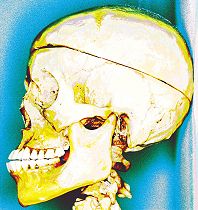2007年VOA标准英语-Latest Research Says Modern Man Comes from Afri(在线收听)
Washington
19 July 2007
The origin of modern humans has been a heated topic among anthropologists, who have debated whether modern man came from Africa or somewhere else. Now, researchers say they have they have proof beyond dispute of the so-called "out of Africa" theory. VOA's Jessica Berman reports.
The "out of Africa" theory holds that modern humans emerged from the continent some 50,000 years ago, replacing more primitive species including Neanderthals that existed on different continents.
The alternative theory, called the multiregional hypothesis, is that modern humans evolved from primitive species in many places around the world.
But in the 1990s, the multiregional hypothesis was largely discredited by the advent of genetic testing.
Still, biologist Andrea Manica of Cambridge University in England says there are anthropologists who believe in the multiregional theory.
 |
"What we did, which I think really in a way brings the whole discussion slightly to a close, is actually to look at genetics and skull morphometrics at the same time with a single sort of framework," she explained. "And actually show that if you ask the question explicitly, 'Do we come from Africa?' Then the answer is yes no matter whether you look at genetics or whether you look at morphometrics."
Manica and colleagues measured 4,500 ancient human skulls from more than 100 populations around the world. She says the size and shape of the skulls were compared to those unearthed in Africa, which she says has a very diverse population.
"You find for example in terms of skulls, quite of a lot of variability on the traits," she added. "You know, how broad faces are and how narrow and deep, and so on."
The investigators discovered that the greater the distance from Africa, the less variability there was among the skulls.
"So, if you take skulls from a population in Africa, there is lots of variability," she noted. "If you go to Europe, there's a little bit less. If you go to Asia, it's going further down. If you go then to North America, it goes further down. And South America is really the most homogeneous in a way of [set] populations."
Manica says that the modern humans who left Africa were far less diverse than the human ancestors who remained behind. And those that traveled further afield were physically even less diverse, contributing to more physical uniformity on the continents where they settled.
The study of the origins of modern humans appears in the current issue of the journal Nature.